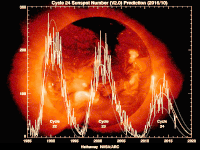Solar variation

Have you ever noticed how the sun looks different during different times of the day and year? Sometimes it's really bright and hot, and other times it's not as bright and feels cooler. This is because of something called solar variation.
Solar variation is all about how the sun's energy changes over time. The sun is like a big ball of gas that is always burning, and it gives off different amounts of energy in different ways. Sometimes it gives off a lot of energy and sometimes it gives off less.
One reason for this has to do with the sun's magnetic field. The sun's magnetic field is like a big bubble that surrounds it. When the magnetic field is strong, it can affect how the sun's energy is released. This can cause things like sunspots or solar flares which can change the amount of energy the sun gives off.
Another reason for solar variation has to do with the sun's rotation. The sun rotates on its axis just like the Earth, but it's much slower. As it rotates, different parts of the sun come into view. Some parts of the sun are brighter than others, so as it rotates we see changes in how bright the sun looks.
Overall, solar variation is just about how the sun's energy changes over time. It's a very natural thing that happens, and scientists are always studying it to learn more about our sun and how it affects our planet.
Solar variation is all about how the sun's energy changes over time. The sun is like a big ball of gas that is always burning, and it gives off different amounts of energy in different ways. Sometimes it gives off a lot of energy and sometimes it gives off less.
One reason for this has to do with the sun's magnetic field. The sun's magnetic field is like a big bubble that surrounds it. When the magnetic field is strong, it can affect how the sun's energy is released. This can cause things like sunspots or solar flares which can change the amount of energy the sun gives off.
Another reason for solar variation has to do with the sun's rotation. The sun rotates on its axis just like the Earth, but it's much slower. As it rotates, different parts of the sun come into view. Some parts of the sun are brighter than others, so as it rotates we see changes in how bright the sun looks.
Overall, solar variation is just about how the sun's energy changes over time. It's a very natural thing that happens, and scientists are always studying it to learn more about our sun and how it affects our planet.
Related topics others have asked about:
